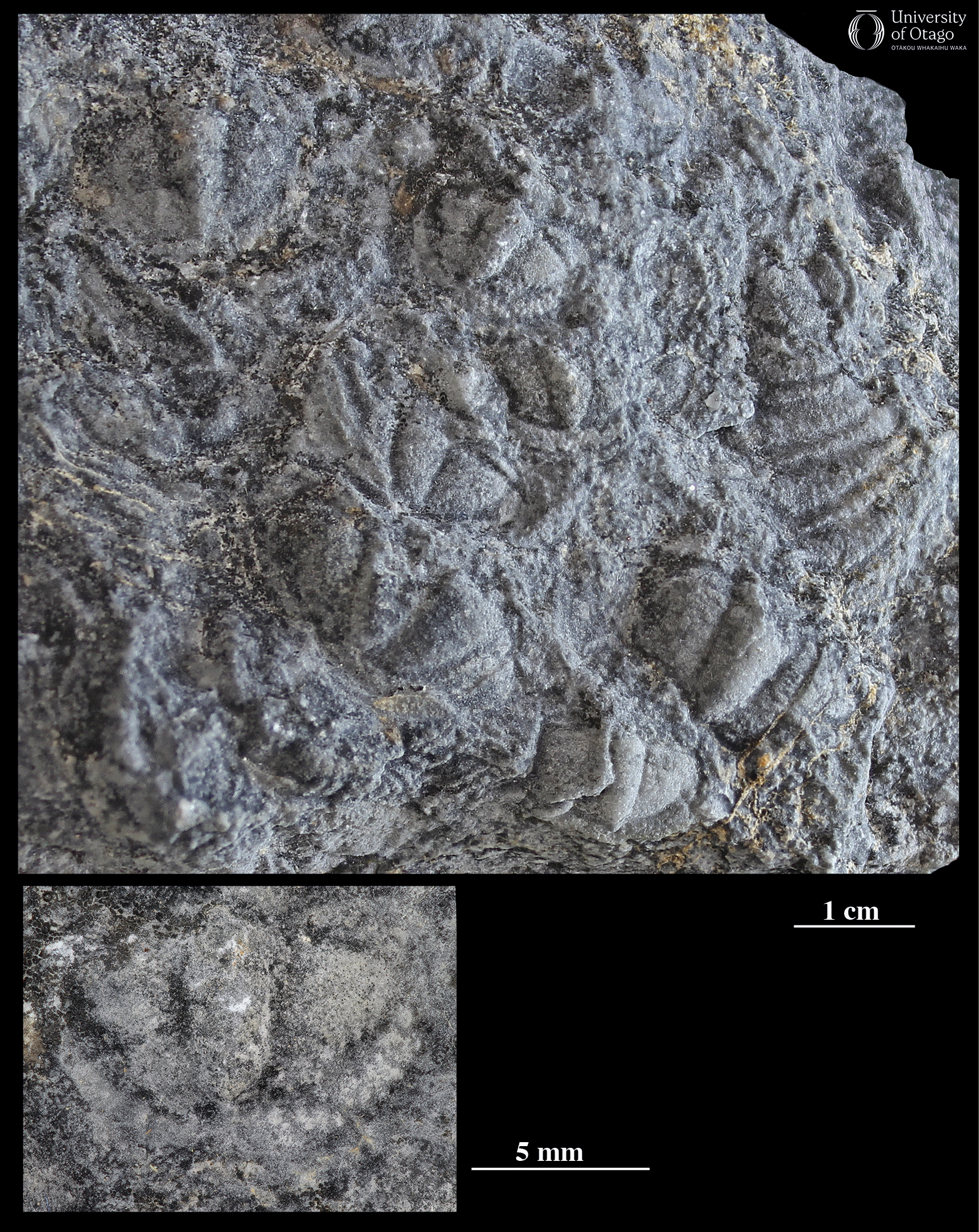48 Valley of trilobites, our oldest fossils
Arthropoda, Trilobitomorpha
Within the Cambrian display in the University of Otago Geology Museum there is a palm-size grey rock which is unremarkable at first glance. Look a little closer though and you will soon notice it is covered in small round structures. Lean in a little closer and take a longer look at one of those round structures. You will see it is a group of body segments that may remind you of a slater or pillbug (an isopod). These body segments are from the carapace of an armoured marine ‘bug’, a trilobite. And now that you know what to look for, take another look at that grey rock. The entire block of grey limestone is made up of trilobites.

Upper image shows detail from a hand sample of ‘Trilobite Rock’ from Cobb Valley, Nelson. The surface features on this rock are carapace segments from many individual trilobites (specimen OU 8258). The lower image shows a closer and more detailed view of one carapace segment. Image credit: JH Robinson. |
The trilobites in this display case are among the oldest fossils known from Aotearoa. They lived during the middle Cambrian, during a time before there were plants on land and when all animals lived in the ocean.
The discovery of Trilobite Rock in Cobb Valley is one of Aotearoa’s great fossil stories. In 1948 local student Malcolm Simpson joined a field trip into the Cobb Valley that was being led by Professor William Noel Benson from the Department of Geology at the University of Otago. During the trip 14-year-old Simpson collected a piece of limestone and passed it Benson, who initially described the fossils it contained as ‘indistinguishable molluscan remains’. It was only later, back in Ōtepoti Dunedin, that Benson determined what had actually been found. After receiving confirmation, Professor Benson phoned the young explorer to let him know that his discovery contained trilobites, the first Cambrian fossils ever recognised in New Zealand.
We encourage you to read ‘The Discovery of the New Zealand Cambrian’ by Alan Mason and Bill Watters for the detailed account.
 |
Did you know there is a 3D printable model of this fossil for you to view online and download? Follow this link to learn more: 3D model—Valley of trilobites, our oldest fossils. |
Trilobites are an entirely extinct group of jointed-limb animals that are distantly related to arthropods living today like crayfish, spiders and flies. Like living arthropods, trilobites had a carapace that they shed and replaced as they grew. The carapace of a trilobite was divided into three major segments, the ‘head’ (cephalon), ‘body’ (thorax) and ‘tail’ (pygidium), with parts from each segment making up the three ‘lobes’ of the carapace that are the namesake structures of trilobites.
The trilobites from Trilobite Rock in Cobb Valley include members of Agnostida, which are distinguished by having a cephalon segment that was a similar size to their pygidium segment. Also, most agnostid trilobites lacked the compound eyes found on other trilobites. So when you are studying the palm-size grey rock in the Geology Museum, take a look to see if you can spot the tri-lobed, symmetrical, and eyeless carapace of an agnostid trilobite!
—Written by Daniel B Thomas
| Specimen number: OU 8258 | Age: Approximately 502 million years ago (middle Cambrian, Undillan or early Boomerangian stage) |
| Locality: Cobb Valley, Nelson | Rock Formation: Tasman Formation |
| Collected by: WN Benson | |
| Citation: Cooper RA. 1979. Lower Palaeozoic rocks of New Zealand. Journal of the Royal Society of New Zealand 9:29–84; Mason A, Watters B. 1999. The Discovery of the New Zealand Cambrian. Geological Society of New Zealand Newsletter 118: 15–20. | |
538.8 to 486.85 million years ago.
An order of crustaceans. There are over 10,000 species of isopod worldwide with around 5,000 terrestrial species, 4,500 species in marine environments, and 500 fresh water species.
Outer shell.
Evidence of life from a past geological age. Remains like bones, shells or wood, or an impression like a footprint, or some other evidence of life, from something that was alive more than 11,700 years ago.
506.5 to 497 million years ago. The middle Cambrian is the international Miaolingian stage.
The process of shedding an exoskeleton in order to grow. Also known as ecdysis.
The head of a trilobite.

